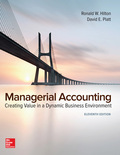
Cathy’s Classic Clothes is a retailer that sells to professional women in the northeast. The firm leases space for stores in upscale shopping centers, and the organizational structure consists of regions, districts, and stores. Each region consists of two or more districts; each district consists of three or more stores. Each store, district, and region has been established as a profit center. At all levels, the company uses a responsibility-accounting system focusing on information and knowledge rather than blame and control. Each year, managers, in consultation with their supervisors, establish financial and nonfinancial goals, and these goals are integrated into the budget. Actual performance is measured each month.
The New England Region consists of the Coastal District and the Inland District. The Coastal District includes the New Haven, Boston, and Portland stores. The Coastal District’s performance has not been up to expectations in the past. For the month of May, the district manager has set performance goals with the managers of the New Haven and Boston stores, who will receive bonuses if certain performance measures are exceeded. The manager in Portland decided not to participate in the bonus scheme. Since the district manager is unsure what type of bonus will encourage better performance, the New Haven manager will receive a bonus based on sales in excess of budgeted sales of $570,000, while the Boston manager will receive a bonus based on operating income in excess of budget. The company’s operating income goal for each store is 12 percent of sales. The budgeted sales revenue for the Boston store is $530,000.
Other pertinent data for May are as follows:
- Coastal District sales revenue was $1,500,000, and its cost of goods sold amounted to $633,750.
- The Coastal District spent $75,000 on advertising.
- General and administrative expenses for the Coastal District amounted to $180,000.
- At the New Haven store, sales were 40 percent of Coastal District sales, while sales at the Boston store were 35 percent of district sales. The cost of goods sold in both New Haven and Boston was 42 percent of sales.
- Variable selling expenses (sales commissions) were 6 percent of sales for all stores, districts, and regions.
- Variable administrative expenses were 2.5 percent of sales for all stores, districts, and regions.
- Maintenance cost includes janitorial and repair services and is a direct cost for each store. The store manager has complete control over this outlay. Maintenance costs were incurred as follows: New Haven, $7,500; Boston, $600; and Portland, $4,500.
- Advertising is considered a direct cost for each store and is completely under the control of the store manager. The New Haven store spent two-thirds of the Coastal District total outlay for advertising, which was 10 times the amount spent in Boston on advertising.
- Coastal District rental expense amounted to $150,000.
- The rental expenses at the New Haven store were 40 percent of the Coastal District’s total, while the Boston store incurred 30 percent of the district total.
- District expenses were allocated to the stores based on sales.
- New England Region general and administrative expenses of $165,000 were allocated to the Coastal District. These expenses were, in turn, allocated equally to the district’s three stores.
Required:
- 1. Prepare the May segmented income statement for the Coastal District and for the New Haven and Boston stores.
- 2. Compute the Portland store’s operating income for May.
- 3. Discuss the impact of the responsibility-accounting system and bonus structure on the managers’ behavior and the effect of their behavior on the financial results for the New Haven store and the Boston store.
- 4. The assistant controller for the New England Region, Jack Isner, has been a close friend of the New Haven store manager for over 20 years. When Isner saw the segmented income statement [as prepared in requirement (1)], he realized that the New Haven store manager had really gone overboard on advertising expenditures. To make his friend look better to the regional management, he reclassified $25,000 of the advertising expenditures as miscellaneous expenses, and buried them in rent and other costs. Comment on the ethical issues in the assistant controller’s actions. (Refer to specific ethical standards that were given in Chapter 1.)
1.
Prepare the segmented income statement for the Month of May.
Explanation of Solution
Segment reporting: Segment reporting refers to the process of preparing accounting report by segment and for the entire organization. Several organizations prepare segmented income statements to show the income for major segments and for the enterprise as a whole.
Prepare the segmented income statement:
| Particulars | District C | Store N | Store B |
| Sales | $1,500,000 | $600,000 | $525,000 |
| Less: Cost of goods sold | $633,750 | $252,000 | 220,500 |
| Gross margin | $866,250 | $348,000 | $304,500 |
| Operating expenses: | $31,500 | ||
| Variable selling | $90,000 | $36,000 | $13,125 |
| Variable administrative | $37,500 | $15,000 | |
| Other direct expenses: | $600 | ||
| Store maintenance | $12,600 | $7,500 | $5,000 |
| Advertising | $75,000 | $50,000 | $45,000 |
| Rent and other costs | $150,000 | $60,000 | |
| District general administrative | $63,000 | ||
| expenses (allocated) | $180,000 | $72,000 | |
| Regional general and administrative expenses (allocated) | $165,000 | $55,000 | $55,000 |
| Total expenses | $710,100 | $295,500 | $213,225 |
| Operating Income | $156,150 | $52,500 | $91,275 |
Table (1)
Note: Refer to table 2 for the computation of amounts.
Working note:
| Particulars | District C | Store N | Store B |
| Sales | $1,500,000 | ||
| Cost of goods sold | $633,750 | ||
| Variable selling | |||
| Variable administrative | |||
| Maintenance | 7,500 | 600 | |
| Advertising | 75,000 | ||
| Rent | 150,000 | ||
| District expenses | 180,000 |
Table (2)
2.
Calculate the operating income of Store P for the Month of May.
Explanation of Solution
The Store P’s operating income for May is $12,375
3.
Discuss the impact of the responsibility-accounting system and bonus structure on the manager’s behavior and the effect of their behavior on the financial results for the Store N and the Store B.
Explanation of Solution
Responsibility accounting: Responsibility refers to the several concepts and tools used by managers to evaluate the performance of departments and people in order to “foster goal congruence”.
“The impact of the responsibility-accounting system and bonus structure on the behavior of the manager and the effect of this behavior on the financial results for the two stores are as follows”:
- (a) Store N:
- The manager has focused on increasing sales and paid lower attention to controllable costs as the bonus on depends on sales over $570,000., due to which the operating income of store is less than 9 percent of sales and only 34 percent of total operating income, even though sales are 40 % of district sales.
- In order to maximize sales, the Store N spent 10 times as much as the Store B on advertising but earned only $75,000 more in sales. Therefore, the advertising should not have been very effective and must be controlled better.
- (b) Store B:
- It is a tendency to cut discretionary expenses like advertising and store maintenance as the manager of the Store B is encouraged to maximize income. Whereas the management is looking forward to control cost by introducing a bonus based operating income, the lack of spending on these “discretionary items” might have an adverse long-term effect.
- The manager of Store B is not satisfied with the addition of allocated district and regional expenses for computing operating income. These expenses are not considerably controlled by the store manager and will decrease the bonus receive the manager of the Store B.
4.
Comment on the ethical issues in the assistant controllers actions.
Explanation of Solution
Competence:
- “Maintain an appropriate level of professional expertise by continually developing knowledge and skills”.
- “Provide decision support information and recommendations that are accurate, clear, concise and timely”.
- “Perform professional duties in accordance with laws, rules and regulations”.
Integrity:
- “Mitigate actual conflicts of interest. Regularly communicate with business associates to avoid apparent conflicts of interest. Advise all parties of any potential conflicts”
- “Refrain from engaging in any conduct that would prejudice carrying out duties ethically”.
- “Abstain from engaging in or supporting any activity that might discredit the profession”.
Credibility:
- “Communicate information fairly and objectively”.
- “Disclose all relevant information that could reasonably be expected to influence an intended user’s understanding of the reports, analyses, or recommendations”.
- “Disclose delays or deficiencies in information, timeliness, processing, or internal controls in conformance with organization policy and/or applicable law”.
Want to see more full solutions like this?
Chapter 12 Solutions
Managerial Accounting: Creating Value in a Dynamic Business Environment
 Managerial AccountingAccountingISBN:9781337912020Author:Carl Warren, Ph.d. Cma William B. TaylerPublisher:South-Western College PubPrinciples of Accounting Volume 2AccountingISBN:9781947172609Author:OpenStaxPublisher:OpenStax College
Managerial AccountingAccountingISBN:9781337912020Author:Carl Warren, Ph.d. Cma William B. TaylerPublisher:South-Western College PubPrinciples of Accounting Volume 2AccountingISBN:9781947172609Author:OpenStaxPublisher:OpenStax College Excel Applications for Accounting PrinciplesAccountingISBN:9781111581565Author:Gaylord N. SmithPublisher:Cengage Learning
Excel Applications for Accounting PrinciplesAccountingISBN:9781111581565Author:Gaylord N. SmithPublisher:Cengage Learning Financial And Managerial AccountingAccountingISBN:9781337902663Author:WARREN, Carl S.Publisher:Cengage Learning,
Financial And Managerial AccountingAccountingISBN:9781337902663Author:WARREN, Carl S.Publisher:Cengage Learning,



